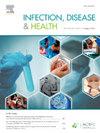凝固酶阴性葡萄球菌的形态:临床相关性和结果的队列研究。
IF 2
Q2 PUBLIC, ENVIRONMENTAL & OCCUPATIONAL HEALTH
引用次数: 0
摘要
简介:凝固酶阴性葡萄球菌(con)是血流感染(BSI)的常见原因,但物种特异性流行病学研究不足。本研究旨在调查澳大利亚大量人群中非典型BSI的发生、临床特征和结果。方法:纳入昆士兰州卫生系统(2000-2019)中所有的CoNS BSI事件。结果:4046例病例中,单菌感染3353例,其中表皮葡萄球菌(1665例)、溶血葡萄球菌(224例)、人型葡萄球菌(220例)、头型葡萄球菌(185例)、lugdunensis(57例)、warneri s(47例)等38种。在27%的病例中,con分离株没有被分配到物种上。不同物种在年龄、发病分类、合并症和氟氯西林耐药性方面存在显著差异。表皮葡萄球菌,溶血葡萄球菌。猪链球菌主要在医院发病,而猪链球菌主要在社区发病。该队列的Charlson评分表明,溶血链球菌患者中恶性肿瘤发生率高。大多数特定的con分离株显示对氟氯西林耐药(2224/2827;79%)。多微生物组的30天死亡率(14%)高于单微生物组(11%),p = 0.024。死亡率因物种而异,最高的是S. lugdunensis(22%)。结论:这些发现强调了物种水平鉴定在管理非传染性脑损伤中的价值,特别是在有临床体征和症状的病例中,以支持抗菌药物管理。本文章由计算机程序翻译,如有差异,请以英文原文为准。
Speciation of coagulase-negative staphylococci: A cohort study on clinical relevance and outcomes
Introduction
Coagulase-negative staphylococci (CoNS) are common causes of bloodstream infections (BSI), but species-specific epidemiology is under-researched. This study aimed to examine the occurrence, clinical features, and outcomes of CoNS BSI in a large Australian population.
Methods
All incidents of CoNS BSI in the Queensland Health system (2000–2019) were included.
Results
Among 4046 CoNS BSI cases, 3353 were monomicrobial, with S. epidermidis (n = 1665), S. haemolyticus (n = 224), S. hominis (n = 220), S. capitis (n = 185), S. lugdunensis (n = 57), S. warneri (n = 47), and other species (n = 38). In 27% of cases, CoNS isolates were not assigned to species. Significant differences in age, onset classification, co-morbidities, and flucloxacillin resistance were observed across species. S. epidermidis, S. haemolyticus. S. capitis were predominantly hospital-onset, while S. lugdunensis was community-associated. The cohort had Charlson scores indicating high co-morbidity, with malignancy common among S. haemolyticus patients. Most speciated isolates of CoNS demonstrated resistance to flucloxacillin (2224/2827; 79%). The 30-day mortality rate was higher for polymicrobial (14%) vs. monomicrobial BSI (11%), p = 0.024. Mortality varied by species and was highest for S. lugdunensis (22%).
Conclusions
These findings underscore the value of species-level identification in managing CoNS BSIs, particularly in cases with clinical signs and symptoms, to support antimicrobial stewardship.
求助全文
通过发布文献求助,成功后即可免费获取论文全文。
去求助
来源期刊

Infection Disease & Health
PUBLIC, ENVIRONMENTAL & OCCUPATIONAL HEALTH-
CiteScore
5.70
自引率
5.70%
发文量
40
审稿时长
20 days
期刊介绍:
The journal aims to be a platform for the publication and dissemination of knowledge in the area of infection and disease causing infection in humans. The journal is quarterly and publishes research, reviews, concise communications, commentary and other articles concerned with infection and disease affecting the health of an individual, organisation or population. The original and important articles in the journal investigate, report or discuss infection prevention and control; clinical, social, epidemiological or public health aspects of infectious disease; policy and planning for the control of infections; zoonoses; and vaccination related to disease in human health. Infection, Disease & Health provides a platform for the publication and dissemination of original knowledge at the nexus of the areas infection, Disease and health in a One Health context. One Health recognizes that the health of people is connected to the health of animals and the environment. One Health encourages and advances the collaborative efforts of multiple disciplines-working locally, nationally, and globally-to achieve the best health for people, animals, and our environment. This approach is fundamental because 6 out of every 10 infectious diseases in humans are zoonotic, or spread from animals. We would be expected to report or discuss infection prevention and control; clinical, social, epidemiological or public health aspects of infectious disease; policy and planning for the control of infections; zoonosis; and vaccination related to disease in human health. The Journal seeks to bring together knowledge from all specialties involved in infection research and clinical practice, and present the best work in this ever-changing field. The audience of the journal includes researchers, clinicians, health workers and public policy professionals concerned with infection, disease and health.
 求助内容:
求助内容: 应助结果提醒方式:
应助结果提醒方式:


